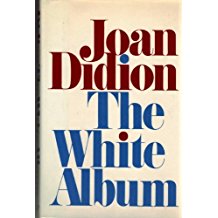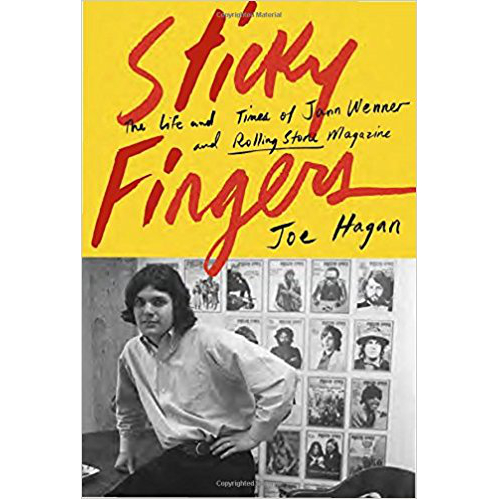 "The White Album"
"The White Album"
Joan Didion, 1979
"Sticky Fingers: The Life and Times of Jann Wenner and Rolling Stone Magazine"
Joe Hagan, 2017
Paintings by David Hockney, from an exhibition at the New York Metropolitan Museum of Art
The collection of essays that make up "The White Album," Joan Didion asserts almost immediately, are about the collapse of meaning, about the dissolution of the narratives told to guide us through life. In the era that she penned them, the late 1960s and early 1970s, western culture itself was shifting, from order to disorder, seemingly. The entrenched powers of the old were giving way to the strength of the young ("They got the guns, but we got the numbers," the Lizard King sang at the time). On the personal level, Didion's defense mechanisms were failing at the same time. So, what is left, this book asks.
"I was meant to know the plot, but all I knew was what I saw," Didion wrote. "We live entirely, especially if we are writers, by the imposition of a narrative line upon disparate images, by the ideas with which we’ve learned to freeze the shifting phantasmagoria which is our actual experience."
Like the 1968 Beatles album it is named after, this collection jumps around quite a bit, resisting thematic cohesion altogether. Centered around Didion's time living in an about-to-be-demolished Hollywood mansion, the book itself lurches along like a trail of memories. The book is loosely centered around Didion's time living in an about-to-be-demolished Hollywood mansion. "It was precisely this anticipation of imminent but not exactly immediate destruction that leant the neighborhood its particular character." This peculiar character of temporariness also permeates the essays themselves, with Didion catching moments of seeming normalcy that feel like they are ebbing away in the moment.
Many pieces were snippets from magazine pieces she wrote at the time. One moment, we are in the recording studio with The Doors, who seem to do almost nothing for hours at end. Soon after, we are bearing witness to the press testimony of Black Panther co-founder Huey Newton, just before he stood trial for the manslaughter of an Oakland police officer.
But a funny thing emerges from this collection: just as Didion journals the dissolution the old narratives, she builds new ones from the rubble. When she meets with one of the Manson Killers, its not her convos with girl, but with the lawyer after that sticks with her. Every detail, no matter how seemingly off topic, is up for grabs in a linear chain of understanding.
In this age of Instagram and Facebook, it's nearly impossible not to create a narrative of your life. Critics argue the social media persona is contrived, but is not all life contrived, empty until imposed upon with meaning of some sort, willfully or no?
As Didion herself puts it, "As the lining of a nerve becomes inflamed and hardens into scar tissue, thereby blocking the passage of neural impulses, the nervous system gradually changes its circuitry, finds other, unaffected nerves, to carry the same message."
California, with its beauty and chaos, provides a backdrop for many of these pieces. "The apparent ease of California life is an illusion, and those who believe the illusion real live here in only the most temporary way," Didion writes. She observed that, for many people living in the arid regions of the U.S. west, a swimming pool was a status symbol, not of luxury, but of control over environment.
Didion sensed that within the rarified environment, the Charles Manson murders at the end of summer 1969 brought about the tipping point of cultural change, where hippie optimism finally gave way to a darker, more complex, narrative.
"Many people I know in Los Angeles believe that the '60s ended abruptly ... at the exact moment when word of the murders on Cielo Drive traveled like brushfire through the community. And in a sense this is true. The tension broke that day, the paranoia was fulfilled," she wrote. "Black masses were imagined, and bad trips blamed. I remember all of the day's misinformation very clearly. And I also remember this and wish I did not: I remember that no one was surprised."
Elsewhere, she looked at how the California reality gets filtered through different people of note. She profiled famous evangelist James Pike, whose charisma had that lack of any memory or mooring so typical of the late 1960s.
"Here was a man who moved through life believing he was entitled to forget it, and start over, to shed women when they became difficult, and allegiances when they became tedious," she wrote. Casting off whatever narratives may have been assigned to him through birth, chance or standing, he dismissed those detractors "who quibbled as petty and judgmental, and generally threatened by his superior, and more dynamic view of human possibility."
She delves into the fictions that Hollywood movies offer, how, for several years, the youth looked towards low budget motorcycle movies of the 1950s and 1960s, as "a kind of underground folk literature for adolescents." She wrote about how Nancy Reagan, wife of then California governor and former actor Ronald Reagan, had that "beginning actresses' habit of investing even the most casual lines with a good deal more dramatic emphasis than is ordinarily called for."
You see the fissures all through the characters she writes about, ones that make you, if you're a self-reflective sort, worry about your own. She writes about how Pentecostal churches that "have their strongest holds in places where western civilization has its most superficial hold," where knowledge comes through "the most tenuous chains of rumor, hearsay, haphazard tickle-down," and whose leader enjoyed a perception of the apocalypse that "neither began with, nor depended upon, the empirical."
One person who greatly capitalized on this age of shifting norms was Jann Wenner, the founder and publisher of Rolling Stone, the defining periodical for the late 1960s and much of the 1970s, argues Joe Hagan's new biography of Wenner and Rolling Stone, "Sticky Fingers."
To provide a voice for the emerging youth counterculture, Wenner was the right person at the right time. Growing up on the west coast, he saw early the power of the emerging psychedelic youth culture. "For the first time in the history of man, young people had the money, the personal freedom, and the free time to build monuments and pleasure palaces to their own taste," Tom Wolf had noted of the 1960s.
These people took their music perhaps most seriously, certainly more seriously than the mainstream press recognized at the time. This oversight, Jenner realized early on, was an opportunity. "The Dionysian energy of rock was destroying the old social forms and inventing a new value system around 'The sacred importance of love and truth and beauty and interpersonal relationships,'" Ralph Gleason noted. Or, as John Lennon told Rolling Stone, at that time, 'rock n roll then was real. Everything else was unreal.'"
"There was a narcotic freedom to Rolling Stone as it charted the late 1960s, the primitive newsprint pages opening like a lotus flower, pedal by pedal, with revelations," Hagan wrote. For marketers, Wenner was the gatekeeper to this demographic, a fact to which Wenner was not oblivious.
Indeed, the Rolling Stone was so revolutionary because it applied the rules of straight journalism to the emerging rock culture. Several years before coming up with the idea of starting a magazine for the emerging hippie culture, Wenner visited "The Melody Maker" in 1965. There, he was "astonished to see a working newsroom. populated with reporters smoking cigarettes and talking shop, a vision of order and professionalism amid the decadence of Carnaby." Working with the same printer, Rolling Stone borrowed the Fleet Street fonts and the pinstripe columns of the recently defunct Ramparts Sunday magazine, setting it apart from the other willfully unconventional underground pubs of the day.
When it came to rock n roll, Jann Wenner was "the fan he purported to be, but that was only one side of him," Hagan wrote. Wenner was also an unrepentant social climber. "Though he walked in-step with the counterculture, he was also a Kennedy-worshipping preppy."
He looked up to John Lennon (literally, Wenner, being 5'6", "so often found himself gazing up at his heroes like a boy vampire"). And he tended to fawn over his heroes, more so than they did in return. Whenever Mick Jagger brought up Jann Wenner's name, said Marshall Chess, "It was always with a dismissive wave of the royal hand. 'He'll do whatever I want.'" Jagger appeared on Rolling Stone's cover more than any other artist, 31 times.
Through his magazine, Wenner, it could be argued, helped normalized gay culture within America. For all its glamorous preening, rock n roll was still almost entirely a male pursuit into the late 1960s. Rolling Stone "made it safe for boys to ogle their male idols as rapturously as any girl might, by adding a healthy dose of intellectual pretense." It was Rolling Stone where Elton John first admitted he was gay.
"'Being gay' said [Jann] Wenner [after the fact], 'gave me a good and finer appreciation of the sexuality of the guys up there on the stage. I could understand ... how sexual this whole thing was.'"
The magazine's voyeuristic eye was, in turn, a stand-in for Wenner himself, who had dabbled in homosexuality through the decades, before finally coming out in 1995. Perhaps by exploring his own sexuality through Rolling Stone, he helped make homosexuality a bit more acceptable to ] mid-America, so too did it prod Wenner into acceptance of his own sexuality.
As the Mansion killings and Altamont both punctured Woodstock-bred feelings of universal peace and love, the unity of the 1960s collective youth culture gave way to individual explorations and self-interests.
Part of this culture fracturing came down to drug use, I suspect. The preference for mind-bending psychedelics seemed to give way to ego-enhancing cocaine. "Unlike psychedelics, which inspired cosmic oneness with other people, cocaine inspired feelings of acute exclusivity, separating the cocaine haves from the cocaine have-nots," Hagan wrote.
In the early 1970s, Wenner took to cocaine like "an Irish poet," Hagan wrote, adding that "Coke eventually distorted all facets of Wenner's life." The Rolling Stone staff suffered through many last- minute frenzied "cocaine edits."
But youth culture's dreams of peace shattered into competing self-interest, "its fragments proved to be even more journalistically interesting," Hagan noted.
Indeed, the first half of the 1970s proved to be the journalistic highpoint of the magazine, which found great young writers (Cameron Crowe, P.J. O'Rourke, Joe Eszterhas), ran epic pieces from Tom Wolfe and other New Journalism writers, and, perhaps most importantly, introduced the world to Gonzo Journalism, through the initial serialization of Hunter S. Thompson's "Fear & Loathing in Las Vegas."
Had Hunter S. Thompson "never come along, Rolling Stone might have survived as a rock n roll trade paper, but instead it was about to become the most adventurous and ambitious newspaper-cum-magazine of the 1970s," Hagan wrote. What an experience "Fear and Loathing" must have been anew in 1971: The whacked but often poetic head trip of a paranoid drugged-up reporter sent out to cover a motorcycle race in the desert. "This was it! As I started reading the now-famous first sentences, I felt a crackle of electricity in the air ... This is going to change everything," Chet Flippo recalled reading the original draft when it arrived the office.
Selling Out to The Man
 Throughout the mid-1970s, Wenner was arguably "the most important magazine editor in America," one
who was "shepherding the generational plot lines of the 1960s into a rambling biweekly serial of rock n roll."
Everywhere, Wenner went, he "walked into a room charged with a back story." Often the stories were grievances
of slights real and imagined. He was Mr. Rolling Stone, the man who was responsible for everything in the magazine.
Throughout the mid-1970s, Wenner was arguably "the most important magazine editor in America," one
who was "shepherding the generational plot lines of the 1960s into a rambling biweekly serial of rock n roll."
Everywhere, Wenner went, he "walked into a room charged with a back story." Often the stories were grievances
of slights real and imagined. He was Mr. Rolling Stone, the man who was responsible for everything in the magazine.
And as Rolling Stone grew in stature, so too worries from its most faithful adherents that the publication would sell out its hippie ideals, for the considerable cash offered by The Man," the man in this case being the record companies and, a few years later, the Madison Avenue ad executive. And their worries were on the mark, at least insofar that Wenner's end-goal wasn't exactly, or at least entirely, to serve this new audience.
“Wenner had, in fact, cast off the youth revolution, such as it was. But it wasn't exactly a betrayal, because he had never subscribed to its political tenants in the first place," Hagan wrote. Instead, what fascinated Wenner was rock n roll, not as a youth movement, but as celebrity culture, one driven by fame, personality, and power (In many ways, Us magazine – founded by Wenner in the 1980s – is just as much part of Wenner's contribution to the Zeitgeist as RS).
The magazine's staff was perhaps the first to pick up on this shifting focus. Just a year after Altamont, Wenner put Mick Jagger on the cover of Rolling Stone. The staff was outraged that the man who bore about as much responsibility for Meredith Hunter's death as anyone – as they exhaustively reported out in the pages of the magazine – was being boosted by Rolling Stone once again.
Not helping matters was Wenner's tendency to fiddle with record reviews to make them more amenable to either record company tastes (or his own quirky views on the music). He even fired Lester Bangs, who is today widely regarded as the best rock critic of the decade, because he considered Bangs' assessments as too negative (admittedly, 1972 was not the best year for rock music). He relied more heavily on Cameron Crowe, an admittedly great rock n roll writer who nonetheless was more empathetic to reporting out on the musical artists whose ads filled the magazine.
The counterculture seemed to be really sensitive by even attempts by the corporate America, to co-opt their music-fueled movement. In late 1969, hippies heaped considerable disdain for Columbia Records ("whose suited executives were indistinguishable from IBM men," Hagan wryly noted) for an ad campaign with the tagline "But the Man Can’t Bust Our Music."
When Rolling Stone took loans from some record companies, it looked to the underground press that he was selling out from its righteous mission of reporting on the cultural battles on the streets and campuses. Various factions of the underground even floated the rumor that Rolling Stone was a front for the Xerox Corporation, which supplied the paper for its publication.
By 1975, the magazine, while continuing an excellent of long-form journalism, nevertheless "no longer pulled culture from the underground and put it above ground. It was following big-budget industry stars from CBS and Warner Brothers," Hagan wrote. As a result, the periodical nearly completely missed out on the exploding punk and new wave happening at in the time, despite the fact that much of it was taking place in New York, where Rolling Stone moved its headquarters to in 1977).
The move of its headquarters from San Francisco to New York City pretty much cemented its status as a traditional magazine glossy. The idea was to "rake in the lucrative ads from alcohol, cigarette, and auto manufacturers, the core industries that powered phonebook-heavy tomes like Playboy and Esquire," he wrote.
Wenner wasn't just attracted to NYC for the ad dollars (and that, as Jane pointed out, the Big Apple didn't carry the still-lingering bad vibes from the Manson murders and associated dark weirdness). He loved that the city was the nexus of power for the modern world. "New York slushed with ad dollars and teemed with Mailers and Wolfes and Ephrons who vyed for choice checkered tables at Elaine’s," Hagan wrote.
In NYC he hired photographer Richard Avedon, whose photos, Wenner remarked, "tell you what power does to people ... They tell you what success looks like."
More Quotes From Sticky Fingers Here...


